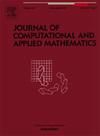Mesh-informed Reduced Order Models for aneurysm rupture risk prediction
IF 2.1
2区 数学
Q1 MATHEMATICS, APPLIED
Journal of Computational and Applied Mathematics
Pub Date : 2025-04-30
DOI:10.1016/j.cam.2025.116727
引用次数: 0
Abstract
The complexity of the cardiovascular system needs to be accurately reproduced in order to promptly acknowledge health conditions; to this aim, advanced multifidelity and multiphysics numerical models are crucial. On one side, Full Order Models (FOMs) deliver accurate hemodynamic assessments, but their high computational demands hinder their real-time clinical application. In contrast, Reduced Order Models (ROMs) provide more efficient yet accurate solutions, essential for personalized healthcare and timely clinical decision-making. In this work, we explore the application of computational fluid dynamics (CFD) in cardiovascular medicine by integrating FOMs with ROMs for predicting the risk of aortic aneurysm growth and rupture. Wall Shear Stress (WSS) and the Oscillatory Shear Index (OSI), sampled at different growth stages of the thoracic aortic aneurysm, are predicted by means of Graph Neural Networks (GNNs). GNNs exploit the natural graph structure of the mesh obtained by the Finite Volume (FV) discretization, taking into account the spatial local information, regardless of the dimension of the input graph. Our experimental validation framework yields promising results, confirming our method as a valid alternative that overcomes the curse of dimensionality.
用于动脉瘤破裂风险预测的网格化降阶模型
需要准确再现心血管系统的复杂性,以便及时确认健康状况;为此,先进的多保真度和多物理场数值模型至关重要。一方面,全阶模型(FOMs)提供准确的血流动力学评估,但其高计算需求阻碍了其实时临床应用。相比之下,减少订单模型(ROMs)提供了更高效、更准确的解决方案,这对于个性化医疗保健和及时的临床决策至关重要。在这项工作中,我们探索了计算流体力学(CFD)在心血管医学中的应用,通过将FOMs与rom相结合来预测主动脉瘤生长和破裂的风险。采用图神经网络(Graph Neural Networks, gnn)方法预测胸主动脉瘤不同生长阶段的壁面剪切应力(WSS)和振荡剪切指数(OSI)。gnn利用有限体积(FV)离散得到的网格的自然图结构,考虑了空间局部信息,而不考虑输入图的维度。我们的实验验证框架产生了有希望的结果,证实了我们的方法是克服维度诅咒的有效替代方法。
本文章由计算机程序翻译,如有差异,请以英文原文为准。
求助全文
约1分钟内获得全文
求助全文
来源期刊
CiteScore
5.40
自引率
4.20%
发文量
437
审稿时长
3.0 months
期刊介绍:
The Journal of Computational and Applied Mathematics publishes original papers of high scientific value in all areas of computational and applied mathematics. The main interest of the Journal is in papers that describe and analyze new computational techniques for solving scientific or engineering problems. Also the improved analysis, including the effectiveness and applicability, of existing methods and algorithms is of importance. The computational efficiency (e.g. the convergence, stability, accuracy, ...) should be proved and illustrated by nontrivial numerical examples. Papers describing only variants of existing methods, without adding significant new computational properties are not of interest.
The audience consists of: applied mathematicians, numerical analysts, computational scientists and engineers.

 求助内容:
求助内容: 应助结果提醒方式:
应助结果提醒方式:


